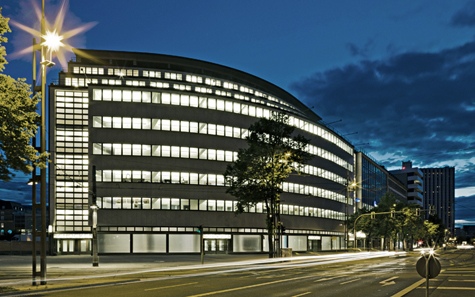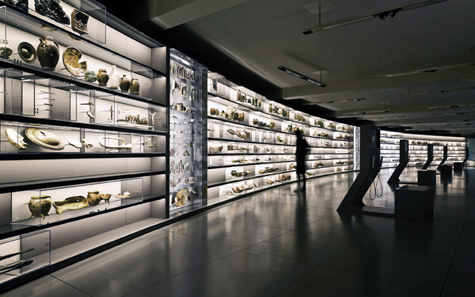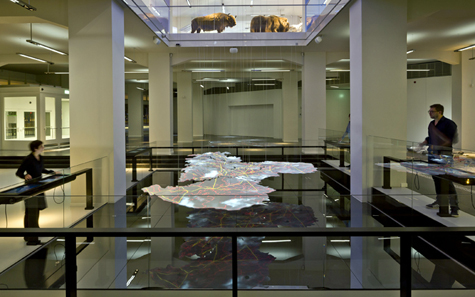June 5, 2014 – Saxony has a large new museum: the State Museum of Archaeology Chemnitz (smac), designed by Atelier Brückner. It sets new standards in the German museum scene. On occasion of the official opening on 15 May, Sabine von Schorlemer, Saxon State Minister of Science and the Arts, described it as ‘showing the way forward both functionally and in terms of design’.
smac: State Museum of Archaeology Chemnitz, facade. Photo: Michael Jungblut.
The museum is located in the former Schocken department store, an icon of classical modernism. Conceptualised by Erich Mendelsohn from 1927 onwards, it was originally opened in May 1930. The conversion of the listed historic building was undertaken by Auer Weber, Stuttgart, and Knerer und Lang Architekten, Dresden. In effect, the character of the department store with its pillar structure and open display areas has been retained. ‘We wanted to change the structure and the ‘legibility’ of the architecture as little as possible, while creating as much museum as possible’, said Prof. Uwe R. Brückner of Atelier Brückner.
The innovative exhibition spans from pre- and early history up to the beginning of industrialisation. Three floors of the ‘Schocken’ are reserved for the museum presentation. Additionally, on the ground floor, the tour of the museum starts with two large staged settings: the time-dynamic model of Saxony and the staged ascent to the exhibitions with a 21-metre-high stratigraphic diorama.
smac: State Museum of Archaeology Chemnitz, panorama wall with everyday objects / Photo: Michael Jungblut.
In the 3,600 square metres of exhibition space, 300,000 years of human history are represented. Visitors are able to experience human beginnings and development in the area now covered by Saxony. They can see how larger and larger areas were settled in the course of time and how people gradually came to structure their surroundings. Analogously to this development, the scenographically presented narrative space of the natural landscape on the first floor changes to the settlement landscape on the second floor and the cultural landscape on the top floor. It becomes more and more detailed and enclosed, while the floor graphic changes from amorphous lines to a rectangular grid pattern.
smac: State Museum of Archaeology Chemnitz, dynamic model of Saxony / Photo: Michael Jungblut.
The two main staged settings of the museum connect the different exhibition areas. The dynamic sculpture of Saxony, shown as a floating landscape model on a scale of 1:35,000, represents the state of Saxony in the centre of the building. Individual parts of the state move vertically up and down between the floors. Accompanied by media-processed data on cultural, political or infrastructural aspects, they serve as visual context for the respective themes on the different levels. As a complementary feature, the 21-metre-high geological profile section in the ascending part of the museum offers a surprising entry into the geologic era and cultural history of the region.
As a supplement to the permanent archaeological exhibition, the museum shows three exhibitions, which are dedicated to the architect Erich Mendelsohn, Salman Schocken and his formerly flourishing department store company. Separated from the permanent exhibition by panorama walls, they are located in the light-filled oriel area, directly at the building’s curved window front.
smac: State Museum of Archaeology Chemnitz, oriel exhibition third level / Foto: Michael Jungblut.
The oriel acts as a membrane, like an intermediate zone between the outside and the inside, between daylight and artificial light, between architecture and exhibition. This conceptual device made it possible to reconstruct the architecture towards the outside so that it retains its historical aura, to tell the story of the building as well as of its protagonists and to stage the exhibition in its own autonomous setting. A rare but all the more successful cooperation between curators, architects and scenographers with an exemplary result.’ (Prof. Uwe R. Brückner)
Under the slogan ‘Discovering Cultures – Understanding History’, the smac is a synthesised cultural and educational experience. ‘The museum will strengthen Saxony as a land of culture; Chemnitz gets a museum that plays in the same league as our national art collections in Dresden.’ (Sabine von Schorlemer, Saxon State Minister for Science and the Arts)
Here you can find the smac website.
To learn more about Atelier Brückner and other museum exhibitions they have designed visit their website.
In addition you may be interested in reading an interview which Prof. Uwe R. Brückner gave once CoinsWeekly regarding scenography and the presentation of coins and medals. You can find the interview in our archive.







